10 Axiomatic Derivations
We now aim for an alternative characterization of the set of formulas of
The Minimal Modal Logic K
The system consists of an infinite set of axioms and two rules of inference.
Definition 10.1 (The System K) The minimal modal logic
substitution instances of tautologis of propositional logic
substitution instances of the axiom:
The rules of inference of
- Modus Ponens (MP):
- Necessitation (N)
We explain what is for a finite sequence of formulas to be a proof in the axiom system we just now introduced:
Definition 10.2 (Proof in K) A proof or derivation in the axiom system
- an axiom of
- the outcome of an application of MP to two prior formulas
- the outcome of an application of N to a prior formula
The theorems of
Definition 10.3 (Theorem of K) A formula
The axioms of the minimal modal logic
Example 10.1 A substitution instance of axiom
How to Construct Proofs
While it is a purely mechanical procedure to check whether a finite sequence of formulas is a proof in a given system, it may take some skill and experience to find one. There is no perfectly general recipe for this, but as a general piece of advice, it helps to spend some time considering the question of why the formula should be valid. Since proofs and theorems of
One important observation at this poins is that we are entitled to propositional inferences within the system. If two formulas are propositionally equivalent, then you should feel free to move from one to the other. Here is a formal justification of that fact.
Proposition 10.1 If
Proof. Given the Deduction Theorem for Propositional Logic, if
In what follows, we will use the annotation ‘PL’ to indicate that a line is justified by propositional logic or by propositional logic applied to some prior lines.
Distribution Rules
We are similarly able to justify derived rules of inference, which will help us take a more direct route between two steps in a proof.
Proposition 10.2 If
Proof. We may transform a derivation of
This justifies a derived rule of inference we annotate RK:
Proposition 10.3 If
Proof. We may transform a proof of
More generally, if
Example 10.2 Consider the derived rule of inference:
Some Theorems of K
We may exploit some of these derived rules in order to prove some theorems of
Proposition 10.4
Proof.
Example 10.3 Given those observations, it is simple to justify:
The crucial observation is that the formula
Other well-known theorems of the minimal logic K are principles such as the distribution of
Proposition 10.5
Proof. The key to this proof is to find appropriate tautologies on which to apply a distribution rule.
Proposition 10.6
Proof. This proof combines the use of a distribution rule with an instance of K.
Proposition 10.7
Proof. The strategy behind the proof is to exploit the fact that
Proposition 10.8
Proof. This time we exploit the fact that a conjunction of necessitations entails the necessitation of a conjunction.
We conclude with another helpful theorem of K.
Proposition 10.9
Proof.
Part of the interest of the minimal modal logic
Normal Modal Systems
We will focus on extensions of the minimal modal logic that result from
Definition 10.4 (Normal Modal Logic) A normal modal
Example 10.4 The modal logic
Two notable normal modal systems are
Example 10.5 The modal logic
Example 10.6 The modal logic
Modal Duality
The axioms below are interderivable from their modal duals:
Example 10.7 Consider the interderivability of
The equivalence proof is completely parallel in all other cases.
We are in a position to compare the deductive strength of different normal modal systems. In what follows, we aim to develop an overview of the landscape of normal modal systems for propositional modal logic.
Definition 10.5 (Extension) A modal system
Here is a graphical representation of some of the relations in which eleven normal modal systems stand to. each other. Each edge connects a modal system with a proper extension located above in the diagram.
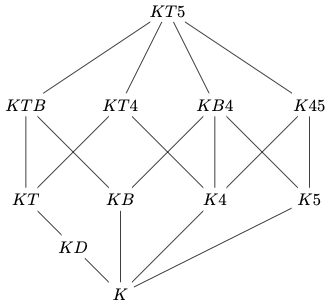 |
| Landscape of normal modal systems |
There are two main techniques we use in order to justify the diagram. To argue that a modal system
Proposition 10.10
Proof. Since
Example 10.8
This is because
There is a semantic counterpart to this observation. We will eventually observe that each normal modal system characterizes the set of validities in a certain class of frames. In fact, each node in the earlier diagram corresponds to a class of formulas valid in a specific class of frames:
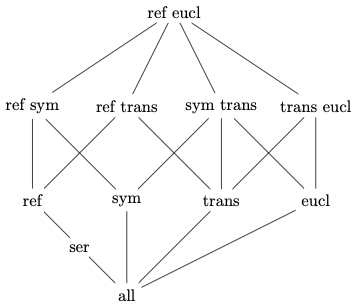 |
| Classes of frames |
We will, for example, explain that the normal modal systems
Proposition 10.11 Every reflexive frame is serial.
That means that if a formula is valid in all serial frames, then it will be valid in all reflexive frames. The soundness and completeness theorems for
On the other hand, the fact that
Proposition 10.12 If every theorem of
Proof. If an axiom
Since the theorems of
Example 10.9
This is because
 |
We may similarly use the fact that axiom 4 is not valid in every reflexive and symmetric frame to establish that some theorems of
Example 10.10
This is because
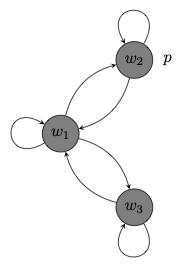 |
Where should we locate
Example 10.11
This is because
Example 10.12
This is because
Example 10.13
This is an immediate consequence of the last two examples.
The Reduction of Pure Modalities
We conclude the survey of the landscape of normal modal logics with a discussion of two salient normal systems,
S4
The normal modal logic
Neither KTB nor KB4 extend S4.
Proposition 10.13
Proof. This is because axiom 4,
 |
Proposition 10.14
Proof. This is because axiom T,
 |
On the other hand,
Proposition 10.15
Proof. This is because axiom B,
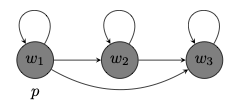 |
One reason
Definition 10.6 (Pure Modality) A pure modality is a finite iteration of zero or more occurrences of the modal operators
Definition 10.7 (Entailment) A modality
Definition 10.8 (Equivalence) A modality
One way in which a normal modal system may enable one to reduce a pure modality to another is by means of one of four main reduction laws:
Example 10.14 If a normal modal system
We use the definition of
For the general study of pure modalities, we distinguish two directions in each of the four reduction laws:
We are now in a position to explain how different normal modal systems enable us to collapse some iterations of pure modalities into simpler ones.
Proposition 10.16
Proposition 10.17
There are at most seven inequivalent pure modalities relative to
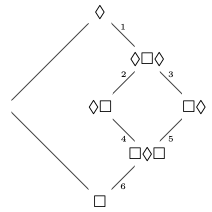 |
| Pure Modalities in |
We now justify the entailments depicted by the diagram. There is, first, entailment 1 in the diagram:
Proposition 10.18
On to entailment 2:
Proposition 10.19
Entailments 3 and 4 are instances of
For entailments 5 and 6, we rely on a lemma:
Lemma 10.1
For one direction, we argue:
We are now in a position to justify entailments 6 and 7, respectively:
Proposition 10.20
Proposition 10.21
We conclude that there is an upper bound on the number of inequivalent pure modalities relative to
Proposition 10.22 There are exactly seven inequivalent pure modalities relative to
Proof. There are exactly three inequivalent modalities of depth 1.
There are two new inequivalent modalities of depth 2:
The reason for this is that
There are two new inequivalent modalities of depth 3:
The reason is that
There are no new inequivalent modalities of depth 4.
By lemma 7.1,
We conclude that there are exactly seven inequivalent modalities relative to
S5
The modal logic
Proposition 10.23
All substitution instances of axiom 4 are theorems of
Proposition 10.24
All substitution instances of axiom B are theorems of
Proposition 10.25
It follows that there are no new pure modalities of depth greater than 1, and that it turns delivers exactly three inequivalent pure modalities relative to
Proposition 10.26 There are exactly three inequivalent pure modalities relative to
Proof. There are exactly three inequivalent modalities of depth 1:
There are no new inequivalent modalities of depth 2.
The reason for this is that
We conclude that there are exactly seven inequivalent modalities relative to